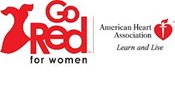February is a month dedicated to the heart – in more ways than one. This is the time to celebrate love and give your sweetheart a valentine. This is also the month to wear red and call attention to prevention of the No. 1 killer of women – heart disease.
During February, the American Heart Association wants people to “Go Red for Women” by wearing something red or a special pin to raise awareness of heart disease. The campaign is a call for women to take charge of their heart health.
“The campaign’s aim is to empower women to take charge of their heart health, make it a top priority and live a stronger, longer life,” says LSU AgCenter nutritionist Beth Reames.
Cardiovascular diseases claim more women's lives than the next seven causes of death combined. “That’s about 500,000 lives a year,” Reames says.
American Heart Association data reveal that:
- Heart disease and stroke are the No. 1 and No. 3 killers of American women over age 25.
- Heart attack, stroke and other cardiovascular diseases kill more than 500,000 women each year – about one death a minute.
- 1 in 29 women dies of breast cancer. About 1 in 2.4 women dies of heart disease, stroke and other cardiovascular diseases.
- 1 in 5 women has some form of cardiovascular disease.
- 63 percent of women who die unexpectedly of heart disease have no previous symptoms.
- Black and Hispanic women have higher risk factors than white women of comparable socioeconomic status.
The campaign has three basic health messages.
First, know your risk factors for heart disease and stroke. These include:
- High blood pressure.
- High blood cholesterol.
- Diabetes.
- Smoking.
- Being overweight.
- Being physically inactive.
- Having a family history of early heart diseases.
- Being 55 years old or older.
Second, reduce your risk.
- Maintain a desirable weight. Keep body mass index (BMI) below 25 and waistline less than 35 inches.
- Exercise for 30 minutes on most days of the week.
- Don’t smoke; if you do, stop.
- Eat a balanced diet (fruits, vegetables, cereal and grain products, fat-free and low-fat dairy products, legumes, nuts, fish, poultry and lean meat).
- Maintain a total cholesterol level under 200 and an HDL level of 50 or higher.
- Control your blood pressure. Try to keep it below 120/80.
- Schedule regular visits with your doctor.
Third, know the warning signs of heart attack. Call 911 immediately if you experience:
- Discomfort in the center of the chest that lasts more than a few minutes or goes away and comes back. It can feel like uncomfortable pressure, squeezing, fullness or pain.
- Pain or discomfort in other areas of the upper body: one or both arms, the back, neck, jaw or stomach.
- Shortness of breath: often comes along with chest discomfort, but it can occur before the discomfort.
- Other signs may include breaking out in a cold sweat, nausea or lightheadedness.
If you’re overweight, try to reach a healthy weight, and stay there. To lose weight, most women should eat 1,200 to 1,500 calories a day, but not less than 1,200. Losing one to two pounds or less per week is considered a healthy weight loss.
Many overweight and obese women have difficulty losing weight and keeping it off. It's important to remember that even modest weight loss (5% to 10% of body weight) can help lower your heart disease risk.
Eating a variety of nutritious foods from the USDA MyPlate food groups – grains, fruits, vegetables, protein foods and dairy – is important for good health and to prevent disease.
Although you may be eating plenty of food, your body make not be getting the nutrients it needs to be healthy. Make smart choices to get the nutrients you need. Choose nutrient-rich foods like vegetables, fruits, whole-grain products and fat-free or low-fat dairy products most often. Nutrient-rich foods have vitamins minerals, fiber and other nutrients.
High blood pressure increases risk of stroke and heart disease complications. A diet that includes natural sources of potassium is important in controlling blood pressure because potassium blunts the effects of sodium. The recommended daily intake of potassium for an average adult is about 4,700 milligrams per day. Fruits, vegetables, fat-free or lowfat (1 percent) dairy foods, nuts and seeds, and fish are good natural sources of potassium.
Too much potassium can be harmful in many older persons and those with kidney disorders. Potassium affects the balance of fluids in the body. With increasing age, the kidneys become less able to remove potassium from the blood. Therefore, before taking any over-the-counter potassium supplement or using salt substitutes that contain potassium chloride, consult your health care professional.







